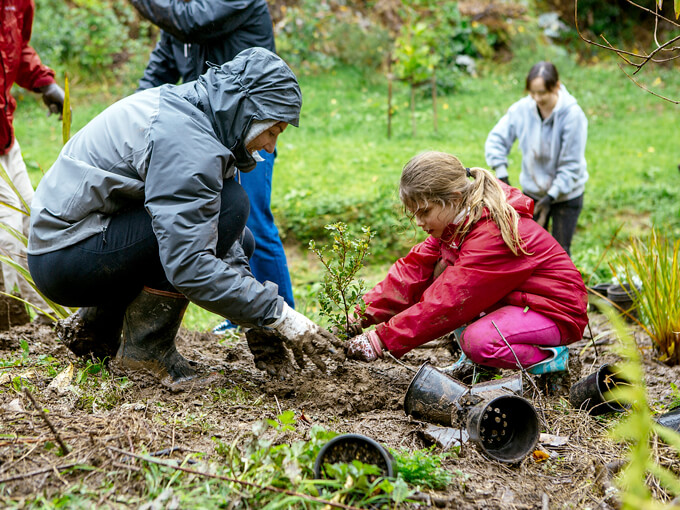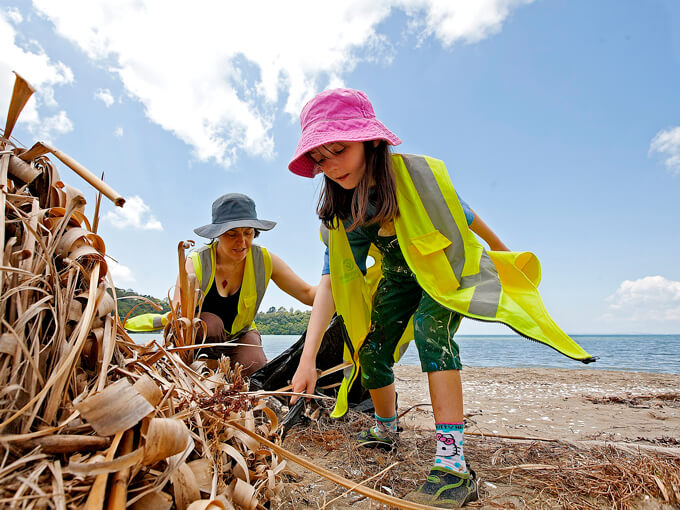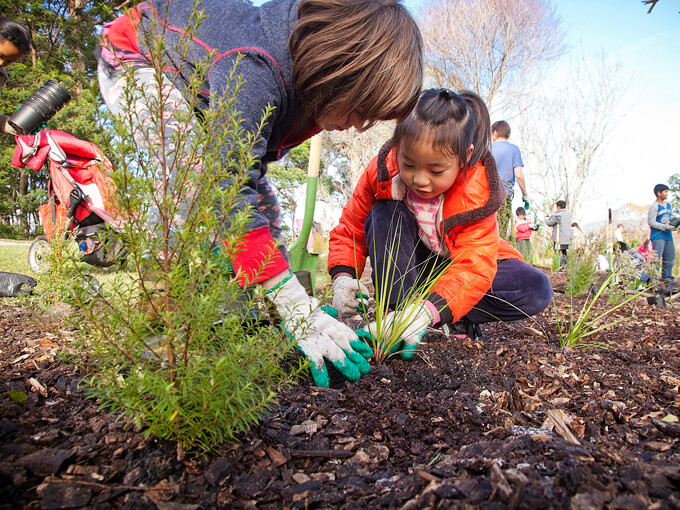Oct 31, 2019 Society
Now more than ever, the planet needs environmental heroes to lead the way to a sustainable future. Hayden Donnell meets some of the many dedicated Aucklanders planting the seeds of kaitiakitanga in the next generation.
This story initially appeared on OurAuckland and is shared with permission.
Twice a week, the children of Pakuranga Baptist Kindergarten walk the underpass across Ti Rakau Drive, then trace the banks of an estuary into an area of native bush. The kids have what their teachers call “markers” along the way. There’s a eucalyptus tree they call he rakau nui (big tree). When they get there, they always look for mushrooms growing nearby and check the smaller plants around its trunk. A little further along the path, they arrive at another tree that looks a bit like a house.
The children pretend fallen branches on the ground are possessions: their couch or their motorbike. Sometimes they’ll pick one up and pretend to do the vacuuming. As they go they collect taonga – pine cones or a wattle flower – if they think it won’t harm the tree.
Pakuranga Baptist is one of about 65 kindergartens and 190 schools across Auckland signed up to the Enviroschools programme, a national scheme that Auckland Council co-ordinates in the region. One of its aims is instilling the idea of kaitiakitanga, or guardianship of the land. Jacqui Lees, Pakuranga Baptist’s kaiwhakahaere (organiser), says that’s come naturally for her preschoolers during their walks.
She’s trying to take that connection one step further and encourage a sense of whenuatanga, or belonging to the land, being a part of the environment. “They talk about, ‘How do we take care of our place?’ Because it is our place,” she says. Mostly the children see the trips as entertainment. “I like to jump in the puddles and get muddy,” Micah, 4, says. “We can swing on the ropes at the big tree, that’s really fun,” adds his classmate Reuben, 4. But there are signs the forays into nature are planting the seed of environmentalism in their minds.
They’re always upset when they see rubbish, says Lees. “We’ve had to phone Auckland Council a couple of times because there have been rubbish bags in the creek that we couldn’t reach. They [the children] talk about, ‘Who would do such a terrible thing? Why do people dump the rubbish in the river? It ruins our special place and the fish don’t like it.’” Marisa Pene, Enviroschools’ regenerative-kaupapa Maori lead, says one aim is for children to think of the land – Papatuanuku – like a family member. “If Papatuanuku is my grandmother in a sense, then how do I relate to her?” she says. “Would I treat her in a way I wouldn’t treat my own grandmother?”
It may not be grand or headline-making, but education programmes like the ones taking place at Pakuranga Baptist kindy and right across Auckland may be our most effective method of addressing the world’s environmental problems. Throughout the city, there’s a growing recognition that teaching values such as kaitiakitanga to the young is just as important as direct conservation action, if not more so.
Organisations are realising it’s important to take the time to shape a better future as well as improving the present. Here’s how Auckland Council is helping to breed a new generation of environmental heroes across three different spheres.

Flora
Emma Bodley remembers the first time she went to an education programme at the Auckland Botanic Gardens. She was five or six years old, and her class was tasked with tracing the lifecycle of leaves, placing them on the ground in order from green, to yellow, to brown. The experience was formative. “From then on, everything I did was in nature. I always played outside. We always went on family trips to Tiritiri Matangi or the zoo and I was always taking notes and drawing what I saw,” she says. Now, when Bodley turns up at the gardens, it’s to serve the 1.2 million annual visitors in her role as a botanic records and conservation specialist.
Often she takes children through the same lesson she got when she was in primary school. “I feel like I’ve come full circle,” she says. Botanic gardens education manager Julia Watson says Bodley isn’t alone. She often hears from people whose childhood trips to the 64ha gardens in Manurewa – which are home to more than 10,000 plants and, like Auckland Zoo, are currently undergoing major redevelopment – left a lasting impression. Some just developed a flair for horticulture. Others became deeply invested in environmentalism. (And the gardens’ education service is not just for kids: there are also experts on hand for those who need guidance on gardening or growing food.) “There’s a lot of research that when you have these experiences when you’re in touch with nature and you’re actually doing something that shows you care for the environment– that you’re part of the environment you’re in – it actually influences you later in life,” Watson says.
Watson’s job is running the gardens’ suite of education programmes, including the school curriculum-based Learning Through Experience and Education for Sustainability, which encourages kids to think and act in ways that will safeguard the future wellbeing of people and the planet. The success of that mission always comes back to fostering a sense that we are all in some sense part of the environment, intricately connected to it and responsible for its health, she says. “The future is a heavy burden but it does rely on our young people caring for the planet. And you can only care if you’ve actually spent time in nature, valuing nature.”
Last year, more than 715,000 people walked through the gates of Auckland Zoo – one of the jewels in the crown of Auckland Council. Kevin Buley, the zoo’s director, knows a lot of folk make the trip to Western Springs for entertainment, but he places Auckland Zoo at the centre of the city’s ecological transformation.
Part of that mission is walking the environmental talk. The zoo has been carbon zero-accredited for two years, has stopped using disposable cups or plastic bags and doesn’t sell products with palm oil. Buley sees those moves as modelling cultural change before it becomes mainstream. “Eight years ago, we stopped using plastic bags here at the zoo, and now we’ve stopped using plastic bags across the entire country. That’s planting a seed and watching it grow in terms of environmental influence – and putting pressure on governments and large corporations.”
He also sees the zoo providing a vital green outpost in an increasingly urbanised Auckland. Island bird sanctuaries such as Tiritiri Matangi can take only limited numbers of visitors, and the zoo should be a place where people can connect with nature sustainably as the city’s population grows to an expected two million people by 2030, he says. “We can’t expect everybody to be able to experience our wildlife on our offshore islands. It needs to be the zoo experience and also, really importantly, enriching the environment in our local neighbourhoods and encouraging wildlife back into those spaces.”
Many of the zoo’s programmes are now focused on facilitating that grassroots neighbourhood environmentalism. There were 51,871 conservation education visits to the zoo last year. Nearly 4000 students from 29 decile 0-3 schools in Auckland and Northland attended free Zoofari education sessions. Another 2757 students attended a conservation education outreach course on which they slept under canvas on Tawharanui Beach, east of Warkworth, and went out at night to spot kiwi by torchlight. Meanwhile, placards around the zoo grounds deliver practical conservation tips.
These programmes are at least as vital as the “intensive” conservation work carried out by zoo staff, Buley says. Environmental transformation can’t be achieved by a few specialists, he believes. Instead, he hopes that change is the result of thousands of everyday actions from people who’ve been influenced by their trips to places like the zoo, even if they went only to see the lions. “Auckland Zoo on its own is not going to save the world. It’s not going to guarantee the future of New Zealand’s wildlife. But those who visit Auckland Zoo, who engage with us and our wildlife, who take on board our advocacy messages and engage with us in conservation action, will absolutely provide fundamental change.”

Water
Most people know Sustainable Coastlines for its work plucking rubbish out of the Hauraki Gulf. The organisation was launched around 10 years ago with an event at Aotea / Great Barrier Island, where hundreds of volunteers – including pupils from lower-decile schools – collected 2.8 tonnes of rubbish. Since then, it’s organised dozens of large-scale clean-ups – and planted more than 100,000 trees – around the country. Auckland Council’s own research suggests clean beaches and waterways are ranked first when it comes to enjoyment of the city. So it’s not surprising that the rubbish collections generate so much publicity.
But Sustainable Coastlines co-founder Camden Howitt says cleaning up beaches and waterways isn’t the most important part of the organisation’s work. Even from that first operation on Great Barrier, educating people and fostering closer connections to nature have been at the heart of its mission, he says, and, since it began, it has shared its presentations to well over 200,000 people. “I think the best way to put that is that if all you do is clean up, then all you’ll ever do is clean up. The analogy is if you’ve plugged in the bath and left the tap running and the water’s overflowing all through your house, you don’t get the mop out and just keep mopping up. You go and you turn off the tap.”
For Howitt, turning off the tap means giving people strategies to live more sustainably and produce less waste. Without that, Sustainable Coastlines would keep going to the same beaches to clear the same waste products, he says. Two years ago, it opened its education centre, The Flagship, at Wynyard Quarter in an attempt to show people – particularly children – how they can live in a way that’s kinder to their local waterways.
Auckland Council’s urban regeneration agency, Panuku, owns the land the centre occupies and helped the charity to bring the idea to life. At its launch, Panuku Place Making Manager Frith Walker said the permanent structure was a perfect fit for the area given Wynyard Quarter’s focus on sustainable design, “because we don’t want to just keep cleaning up, we want to restore, protect and eventually regenerate this environment that humans have degraded”. Howitt says the core focus is to provide education that creates environmental behaviour change. A focus on empowering people is also at the heart of Wai Care’s work.
The Auckland Council initiative gives out free water quality testing kits to help individuals or groups care for their local freshwater streams. Council Healthy Waters Specialist Gabi Ezeta says the programme addresses two of the biggest problems facing efforts to improve Auckland’s water quality: people’s lack of knowledge of how their actions affect waterways, and the feeling they can’t do anything to address the issue. “Humans have a very strong connection to water, mainly because we can’t live without it. However, there is a lack of understanding of how our daily activities can affect the quality of the water, and learning about this from an early age will help children make the right decisions and empower them to be guardians of our waterways when they grow up.”
For evidence of the profound sense of connection being in nature can instil, look to the children of Pakuranga Baptist kindy. They recently travelled to the nearby maunga, Ohuiarangi / Pigeon Mountain. Jacqui Lees says the class made their own story explaining the special trip. In their minds, Ohuiarangi was lonely. She (the maunga) wanted to sit on a swing with a child on her lap, but couldn’t move anymore. So Ohuiarangi called out for the children to visit her. When they got there, they climbed up her face and did roly-polys down again. “This tickled Ohuiarangi and now they have a relationship with her,” Lees says. “She is our mountain. She loves us and we love her.”
This story was first published on Our Auckland.
Follow Metro on Twitter, Facebook, Instagram and sign up to our weekly email?






